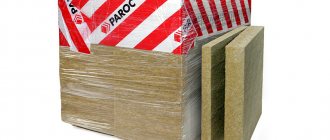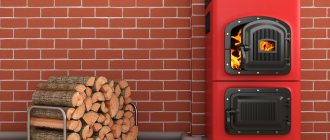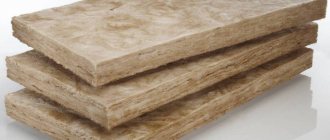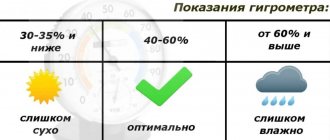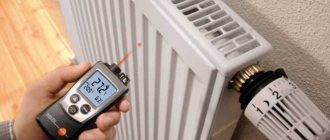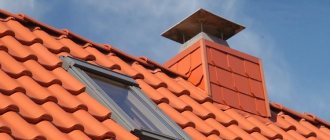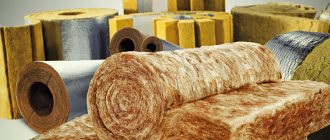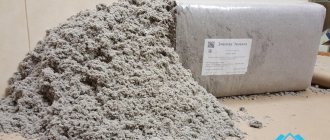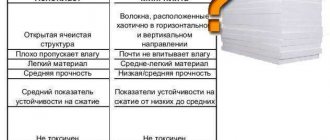Finishing the facade with plaster over insulation allows you to quickly and beautifully seal the walls from external influences and extend the service life of building materials. This technology is available for independent implementation; when choosing it, there is no need to install suspended and frame systems or lengthy interruptions of work processes. The maximum effect is achieved when using insulation and finishing from one manufacturer; the required amount is ideally calculated at the stage of design and construction of the house. The cost depends on the type of thermal insulation and the brand of plaster.
Review of the best thermal insulation options
The required material must combine lightness, good insulating properties, resistance to moisture and external influences, and durability. Preference is given to rigid slabs that retain their shape unchanged throughout their entire service life, ideally non-flammable. Stone wool and polystyrene foam of different brands have qualities suitable for facades; for general purposes, they have slightly different installation and finishing technology. The cake scheme includes three main layers: slabs, reinforced mesh and plaster mortar, the latter can combine the function of protection and decoration or, conversely, require additional painting.
The advantages of polystyrene foam include a closed cell structure, moisture resistance, low density, easy installation and affordable cost. The maximum effect is achieved by using specialized locking and tongue-and-groove systems with milled external surfaces that eliminate the formation of cold bridges and better adhere to the plaster. TechnoNIKOL Carbon, Penoplex Facade and their analogues have suitable characteristics, but if necessary, ordinary brands (PSB, Knauf) with a density of 25 kg/m3 are also suitable. The disadvantages of this option include not the best resistance to mechanical damage, flammability and the need for additional fasteners and mesh reinforcement.
The use of basalt wool for façade insulation followed by plastering is chosen if there is a desire to maintain the permeability of wall materials or high fire safety requirements. In this case, not just any type of mineral wool is suitable: for obvious reasons, they must be hydrophobized, the required minimum density is 130 kg/m3: the stiffer they are, the better. In order to reduce the load on the foundation, specialized grades can be used - lightweight on the one hand, rigid and designed for applying mortar on the other.
The moisture resistance of such basalt slabs is enhanced due to the special arrangement of fibers and impregnation with special compounds; a small part of the absorbed sediment is not retained inside. Despite the higher adhesive strength than smooth foam, it still needs a reinforced mesh, in particular, when covering the main facade plaster with a finish of a different brand and/or in order to increase the strength of the outer layer.
The considered disadvantages of stone wool include deterioration in insulating properties during operation and a slightly worse thermal conductivity coefficient compared to polystyrene foam. This insulation is more expensive and places a higher load on foundation structures.
Comparison of main characteristics:
| Indicator name | TechnoNikol | |
| Basalt slabs Technofas | Extruded polystyrene foam Carbon Eco (for facade and plinth) | |
| Thermal conductivity coefficient, W/m°C | 0,038-0,041 | 0,034 |
| Material density, kg/m3 | 140 | 30 |
| Compressive strength, kPa | 45 | 250 |
| Temperature range of application, °C | -60 to +200 | From -70 to +75 |
| Vapor permeability coefficient, mg/m h Pa | 0,3 | 0,011 |
| Flammability group | Ng | G4 |
The main criteria when selecting a specific type are the material and load-bearing capacity of the base, safety, installation costs, compatibility with the selected plaster mixture and expected service life. In terms of compliance with fire standards, ease of fastening and maintaining the permeability of walls, stone wool definitely wins. In terms of price, lightness, moisture resistance and durability - polystyrene foam. The operating conditions of the thermal insulation layer play an important role - for the base and areas close to the ground, you should buy an option with a closed structure; compacted foam plastic has suitable characteristics.
Recommendations for insulation
The maximum effect is observed when placed in two layers with jointed seams; this design eliminates the formation of cold bridges. Fiber insulation under wet plaster is protected from ground moisture, the bottom slabs are installed on a special base profile. Fastening is carried out using glue; polystyrene foam is additionally fixed with disc-shaped dowels. In stressed areas (corners, openings, expansion joints, junctions with the roof), both types are protected with special profiles; in addition to maintaining the required level, they enhance the quality of adhesion to the mortar.
In order to improve the performance of thermal insulation and reduce costs when implementing it, a number of recommendations are followed:
Common myths about stone wool
The following myths about the dangers of stone wool are very common among people:
Common myths about the dangers of basalt wool
Myth 1: Releases harmful substances into the atmosphere
As I said above, the production of this insulation is carried out using resins. Therefore, many people are sure that the material releases formaldehyde into the environment, which is harmful to health.
There are harmful substances in the composition - a binder, i.e. resin, includes formaldehyde and phenol. These substances can indeed be significantly harmful to health.
Mineral wool can be used for internal insulation of housing due to its minimal content of harmful substances or their complete absence
However, the resin is in a processed form, in addition, its amount in stone wool does not exceed 2-3 percent. Those. the formaldehyde content is so low that it is not released into the atmosphere. Therefore, insulation materials based on basalt wool comply with GOST R 52908-2008 (EN 13820-2003).
Some mineral wool manufacturers refuse to use chemical resins altogether. As a result, the material is completely environmentally friendly.
Stone wool causes virtually no skin irritation
Myth 2: Causes severe skin irritation and serious illness
You can often hear that basalt wool is harmful to health due to sharp and fragile fibers, which, if they come into contact with the skin, cause irritation and allergies. In reality, this statement is also not true.
This myth is due to the fact that stone wool is judged by the well-known glass wool, or these two materials are simply confused. Glass wool does cause skin irritation and can also cause serious respiratory problems.
The damage from basalt fiber is significantly less than from glass, since the fibers are not as fragile. From my personal experience I will say that even when working with mineral wool in the summer, no particular discomfort arises.
You need to wear gloves when working with mineral wool
When basalt wool gets on the skin, it can cause a tingling sensation, but once you shake it off, it goes away. Of course, you need to wear gloves when working with it yourself.
True, all of the above applies only to basalt insulation. The fibers of slag wool are almost as brittle as those of glass wool. But, as I said above, recently slag wool has practically not been used for home insulation.
The elastic basalt fibers that make up the slabs generate virtually no dust.
Myth 3: the material is very dusty
Many people believe that basalt wool is harmful to health due to its strong dusting. Dust can harm the respiratory system.
Of course, if basalt wool gets into a person’s lungs, there is little good in it. But the misconception about heavy dusting, like the previous myth, is associated with the characteristics of glass wool. In reality, the material cannot cause harm for the following reasons:
- The fibers are elastic. Due to the elasticity of basalt fiber, there is much less dust from it. The insulation itself does not generate dust at all;
- Large dust is generated. During the cutting process, the dust generated is quite large, and as a result does not pose a threat to health;
- Use of waterproofing. The installation instructions for this thermal insulation material require the use of vapor barrier. Those. it is covered with a film and, accordingly, cannot cause any harm to health, even if it were dusty.
Insulating wooden walls with mineral wool will preserve the natural microclimate in your home
At the same time, due to the fibrous structure, stone wool insulation has high vapor permeability. This allows you to maintain the natural microclimate in your home if the walls, for example, are made of wood or other vapor-permeable materials.
Myth 4: stone wool becomes damp and harmful microorganisms grow in the structure
According to another myth, basalt wool can cause harm to health indirectly, since it is very damp. As a result, mold and other harmful microorganisms may appear in it.
Hydrophobizing impregnations make mineral wool moisture resistant
In reality, manufacturers treat basalt slabs with water-repellent impregnations. As a result, even when the insulation is immersed in water for a long time, the level of moisture absorption is no more than a few percent of the volume. Some manufacturers even allow installation of insulation without the use of waterproofing materials.
In addition, thermal insulation material is often treated with special antiseptic compounds, which completely eliminate the possibility of the appearance of microorganisms.
Mineral wool does not burn even under direct fire
As you can see, there is no harm to health from stone wool. In many ways, this insulation is even more environmentally friendly than its polymer counterparts. The latter, for example, emit strong toxic substances during combustion, and mineral wool, as is known, does not burn at all.
A more environmentally friendly insulation than basalt wool is ecowool. This material is made on the basis of cellulose fibers and does not contain any harmful chemicals.
Buy insulation only from well-known manufacturers
However, keep in mind that all of the above applies to materials from well-known manufacturers, such as:
- TechnoNIKOL;
- Rockwool;
- Izover, etc.
Uncertified artisanal stone wool can be truly harmful to health. Actually, this applies to any building materials.
When purchasing insulation, pay attention to the area of its application. The environmental friendliness of materials for external work may be lower than those for internal work.
Therefore, price should never be the deciding factor when choosing insulation. In addition, try to purchase materials from large construction stores.
Features and benefits
Mineral wool is a fibrous slab with dimensions of 60x120 and 50x100 cm. The thickness of the products is 5, 10 and 15 cm. Ten-centimeter slabs are the most in demand. This thickness is sufficient for using the material in harsh climatic conditions, under the influence of negative temperatures and large amounts of precipitation.
The fiber density of facade slabs is slightly higher than that of the material intended for interior decoration and corresponds to 130 kg/m3. The high density and elasticity of mineral wool are necessary conditions for its installation under plaster. The slabs must withstand the weight of the applied solution and retain their original qualities when it dries.
Due to the fact that most of the country is located in a cold climate zone, mineral wool is in high demand in the domestic building materials market.
The popularity of the material is due to a number of undeniable advantages:
- The excellent heat and sound insulation properties of wool guarantee heat retention at temperatures below 30 degrees, and reliably protect the home from street noise;
- High fire resistance and non-flammability of the material guarantee complete fire safety of the slabs, which begin to melt only at a temperature of 1000 degrees;
- Rodents, insects and other pests do not show interest in mineral wool, so their appearance in it is excluded;
- Excellent vapor permeability promotes moisture removal and rapid elimination of condensation;
- Resistance to moderate mechanical stress significantly increases the service life of the facade, and makes the use of cotton wool preferable to the use of polystyrene foam;
- The absence of the need for additional thermal insulation of interpanel seams solves the problem of heat loss in large-panel buildings;
- The low cost and availability of the material make it possible to finish large areas at minimal cost.
The disadvantages of mineral wool include the presence of formaldehydes in its composition, which have a negative impact on the health and well-being of others. When purchasing, you need to make sure that you have a certificate of conformity and markings from the regulatory authority. This will help avoid purchasing low-quality products and will guarantee the safety of raw materials.
Mineral wool installation work must be carried out using personal protective equipment. The disadvantages include the need to treat the slabs with a hydrophobic compound. If this is not done, the cotton wool will absorb moisture and lose its thermal insulation qualities.
Mineral wool is produced in three modifications, which differ in composition, purpose and performance characteristics.
- Glass wool. Made from sand, soda, borax, dolomite and limestone. The fiber density corresponds to 130 kg per cubic meter. The material is able to withstand heavy loads, has a thermal resistance limit of 450 degrees and thermal conductivity of up to 0.05 W/m3.
Fiberglass wool - does it burn or not?
This type of mineral wool heat insulator is considered very affordable, and thanks to this, it is often used in the process of installing thermal insulation. The main difference between the material and stone and slag wool is its special structure with prickly fibers. Working with her is difficult and scary.
The thickness of glass wool fibers can be from 5 to 15 microns, the length can vary between 15-50 millimeters. It is due to them that the heat insulator is so durable, elastic and flexible. Work with glass wool primarily in protective clothing, a respirator and gloves.
With a minimum coefficient of thermal conductivity, the heat insulator can burn at temperatures from +500 degrees Celsius, but manufacturers advise not to allow heating above 450 degrees.
Installation technology
Before you begin cladding the facade, you need to prepare the wall surface. To do this, it is necessary to clean it from oil contaminants and dismantle the metal elements. If it is not possible to remove them, then they should be provided with a constant flow of air, which will prevent their premature corrosion and destruction. In such a situation, you should refrain from using acrylic plaster due to its poor ventilation. Old plaster and remaining paint must also be removed.
The next step should be hanging the wall. To do this, you need to drive in reinforcing pins and stretch nylon cords between them. The use of sags will help to evaluate the geometry of the surface and correctly calculate the required amount of material. Next, you can begin installing the guide profile. You need to start with the installation of the base element, which will serve as a supporting guide for the first row of slabs and will allow you to control the distance between the bottom row and the wall surface.
After installing the guide profile, you should begin cladding the facade with mineral wool. When fixing the slabs, you can use driven dowels or special glue. Then the mineral wool is reinforced with a metal mesh, the lower edge of which should be folded under the profile. The mesh must be secured with adhesive-reinforcing plaster.
The final stage will be covering the mineral wool with decorative plaster. For finishing work, you can use silicate, mineral, acrylic and silicone plaster mixtures. It is recommended to paint the plastered surface.
Mineral wool allows you to quickly and effectively solve the problem of facade cladding, significantly reduce heat loss and significantly save your budget. And the ease of installation and accessibility ensure the material’s growing popularity and high consumer demand.
See video instructions for installing mineral wool below.
In the process of building houses and cottages, various types of insulation are used.
And if you are building or reconstructing your home yourself, then sooner or later you will be faced with the question of which insulation to choose?
Today, the building materials market has a huge selection of manufacturers and brands of insulation.
All of them are designed for insulation of walls, roofs, facades, floor coverings and much more.
What burns in mineral wool
At first glance, mineral wool is a natural material. To obtain it, they take raw materials (ideally pure rock, for example, basalt, but more often slag from ferrous or non-ferrous metallurgy or glass waste, because they are much cheaper), immerse them in a special furnace, obtain a melt, which is then split into fibers and formed final product. At the same time, a special binder is added to the mineral wool, and sometimes additional components are designed to combat the excessive hygroscopicity of the mineral wool.
It is these additional components that burn, and mineral wool in practice loses the “honorary title” of a non-combustible material.
An involuntary question arises: if mineral wool burns, why is it considered a non-combustible material? After all, some tests must be carried out. In other words, where are the inspectors looking?
Classification of insulation by density level
Usually everyone remembers school physics and associates the density of insulation with weight and mass.
The heavier the better, but this does not always follow true, depending on what factors and what operating conditions.
The choice of insulation directly depends on the budget, as paradoxical as it may sound, and of course the load on the structure as a whole or on a specific element.
Based on the density of the material, the following classification is distinguished:
Extra light
These include polystyrene foam (expanded polystyrene), which has a porous structure.
Fire protection temperature depending on the type of wool
The temperature range that various types of such fire-resistant materials can withstand as much as possible during long-term operation:
- Kaolin (mullite-silica) wool grade MKRR-130 – 1150℃; MKRH-150 – 1300℃.
- Basalt mineral wool – up to 1200 degrees Celsius.
- Silica wool – up to 1100℃.
- Glass wool – 450℃.
- Slag - up to 300℃.
*** Even kaolin (mullite-siliceous) wool, although made from molten stone raw materials at a temperature of 1750℃, but containing binders with a lower melting limit, cannot withstand a critical thermal Fire-resistant wools are not intended for use in such extreme conditions.
For these purposes, other fire-resistant materials and products with protection against temperatures above 1580℃ are used.
What insulation density should I choose?
This question often comes up during the construction of buildings; here you should rely on the standards provided for construction.
Up to 100 kg/m3
- Insulation materials with a density from 11 to 35 kg/m3. They have a low specific gravity, are lightweight types of insulation, and are also very elastic. Recommended for use on roofs and roofing.
- Insulation materials with a density from 35 to 75 kg/m3. It is used for insulating internal partitions, ceilings and walls of various shapes. It has found wide application for insulating the walls of frame houses.
- Insulation materials with a density from 75 to 100 kg/m3 . This type of insulation is widely used for wrapping ventilation pipes, heating mains, and oil pipelines.
From 100 to 150 kg/m3
- Insulation materials with a density from 100 to 125 kg/m3. For facades, they must be ventilated or have siding.
- Insulation materials with a density from 125 to 150 kg/m3 . It is used for insulating walls made of reinforced concrete, brick, as well as interfloor ceilings.
From 150
- Insulation materials with a density from 150 to 175 kg/m3 . Used for cladding load-bearing structures.
- Insulation materials with a density from 175 to 225 kg/m3 . Due to its characteristics, it is used under a screed or as a rough layer under the finishing floor covering. Such materials have increased combustion resistance.
What insulators are classified as mineral wool?
To find out whether the insulation burns or not and at what temperature, you need to know about its properties and characteristics.
According to GOST, the class of thermal insulators made of mineral wool includes:
- slag wool;
- glass wool;
- stone wool.
All these insulation materials differ from each other not only in the thickness and length of the fibers, but also in their location. Accordingly, indicators such as thermal conductivity, moisture resistance, sound absorption and combustion are different.
Main characteristics of insulation
As we all understand, most characteristics are interconnected. For example, thermal conductivity and density are not directly related to each other, as it seems at first glance.
It all depends on the structure of the material, so if we look at expanded polystyrene, it consists of air balls in the structure of expanded polystyrene and therefore a change in density has practically no effect on thermal conductivity.
And if we take mineral wool, the basis of which is basalt fibers. Then it consists of fibers that are intertwined, and air is contained between them, that is, the higher the density, the less free air and, accordingly, the higher thermal conductivity.
Noise insulation
Sound insulation directly depends on density; the less air permeability of the material, the better the sound absorption.
That is, the denser the material, the better, but such material weighs a lot and is difficult to process and is inconvenient to work with. But manufacturers have made specialized brands of insulation for internal sound insulation.
Izover, Rockwool made insulation from glass wool with the thinnest and longest threads, as well as basalt insulation with randomly twisted fibers and the density of such materials is about 50 kg/m3.
There are also brands with non-uniform hardness, one side is compacted on the outside, and the other is soft on the inside.
The density and thickness of the insulation has a direct relationship. That is, for different types of floors, different insulation materials are required, both in thickness and in terms of thermal insulation density and sound insulation.
From here we conclude that the thickness depends on its application:
- For roofing – 20-30 cm.
- For the basement - 5-15 cm.
- For the attic - 10-15 cm.
- For external walls – 5-10 cm.
Comparison of insulation materials
And now we will compare some insulation materials.
Mineral wool
One of the universal materials, density varies from 30 to 200 kg/m3.
It is used for finishing almost all structural elements of buildings. Available in water slabs, mats, rolls.
Most large mineral wool manufacturers (TechnoNIKOL, Knauf, Izorok) produce mineral insulation.
There are also manufacturers who produce mineral wool with certain characteristics.
Ursa, Knauf produce materials with a density from 11 to 35 kg/m3, which are suitable only for roofing work.
Polyethylene foam
It has a density of up to 25 kg/m3, and is used as a substrate for finishing floor coverings. There are options using foil, they have a density of about 55 kg/m3, they are mainly used for walls.
Basalt wool is a suitable insulation material
Among all the indicated varieties of mineral wool, basalt wool is considered the most non-hazardous, including in terms of flammability. The fibers of the material are similar in size to slag fibers, but unlike the former, they are not at all dangerous and do not require specialized protection during installation work.
The thermal conductivity index of basalt wool is very small, and the temperature
melting can reach 600 degrees Celsius.
An improved version of basalt wool is considered to be insulation made from basalt wool made from gabbro or diabase. Unlike stone, basalt additionally includes belite sludge and mineral elements:
- dolomite;
- clay;
- limestone.
Due to impurities, the heat insulator shows fairly high fluidity rates. It is also worth saying that there is practically no formaldehyde resin in basalt mineral wool, which reduces the risk of phenol evaporation, albeit against the background of a decrease in the ability to resist moisture.
Since there are practically no elements in basalt mineral wool that are unstable to high temperatures, the material can retain functionality when heated to 1000 degrees Celsius.
Both mineral wool and basalt stone, at the melting temperatures stated by the manufacturer, do not ignite, but only melt, which cannot be said about glass and slag wool.
